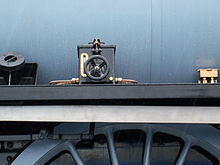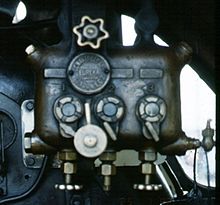- Mechanical lubricator
-
A Mechanical lubricator, or automatic lubricator, is a device fitted to a steam engine to supply lubricating oil to the cylinders and, sometimes, the bearings and axle box mountings as well.[1] There are various types of mechanical lubricator.
Contents
Displacement lubricator
The displacement lubricator was introduced in the United Kingdom in 1860 by John Ramsbottom. It operates by allowing steam to enter a closed vessel containing oil. After condensing, the water sinks to the bottom of the vessel, causing the oil to rise and overflow into delivery pipes. The oil from the delivery pipes is introduced into the steam pipe, where it is atomised and carried to the valves and cylinders.
In early applications in steam locomotives, either two displacement lubricators (one for each cylinder) would be positioned at the front of the boiler near the valves, often on either side of the smokebox or one lubricator would be placed behind the smokebox. The behind smokebox configuration has the advantage that a good connection can be made to the steam pipe and was used by the Great Western Railway. It has the disadvantage that the lubricator's accessibility is reduced and additional drain pipes are required to be connected to the waste to avoid it dripping onto the boiler[2].
Later types of lubricator (from around 1887[2]), referred to as the "sight-feed" type, allowed a sight glass to be positioned in the cab where the rate of oil feed could be observed.
The displacement lubricator was a useful stop-gap but had the disadvantage that it was difficult to accurately control over the rate of oil feed and lubrication was only supplied when the engine was doing work (when a locomotive is coasting with the regulator closed, no steam is present to operate the lubricator).
In the Ramsbottom type the flow of lubricant depended mainly on the weather. In cold weather the rate of feed would increase because steam would condense more rapidly. The Roscoe type lubricator, improved the situation by providing a valve with which to regulate the flow of steam and hence lubricant. Setting the valve correctly required experience and depended on the speed of the train[2].
The Roscoe lubricator was invented by James Roscoe in 1862 and patented in British Patent 1337. It incorporated two improvements over the original Ramsbottom type, the ability to control the quantity of steam which entered the lubricator, via a control valve, and the addition of an air filled chamber within the oil reservoir. The chamber expanded when steam was cut off, the aim of which was to supply oil even when the locomotive was coasting. However, this proved ineffective in practice, particularly if the locomotive was coasting for a long time (e.g. down a hill)[2].
When more sophisticated lubricators, such as the Wakefield and Detroit types, were developed, displacement lubricators fell out of use but they are still used on model steam engines [3].
Wakefield lubricator
This was patented by Charles Wakefield in the 1890s [4].
Detroit lubricator
This was made by the Detroit Lubricator Company.
Silvertown lubricator
Developed by the Midland Railway and made by Gresham and Craven
See also
References
- ^ "Lubrication". Handbook for steam locomotive enginemen. London: British Transport Commission. 1957. pp. 126–128. OCLC 505163269.
- ^ a b c d Lubrication of Locomotives, B.L. Ahrons 1922, The Locomotive Publishing Co. Ltd.
- ^ http://www.stuartmodels.co.uk/accessories.cfm/mainaccess_type/18/the_type/Displacement%20Lubricators
- ^ http://www.castrol.com/castrol/multipleimagesection.do?categoryId=8268009&contentId=6003669
External links

This steam locomotive-related article is a stub. You can help Wikipedia by expanding it.


